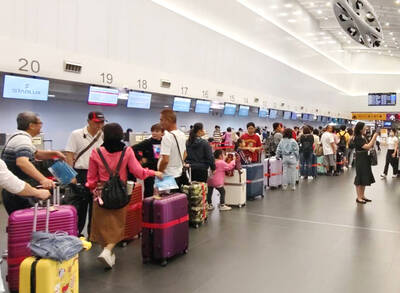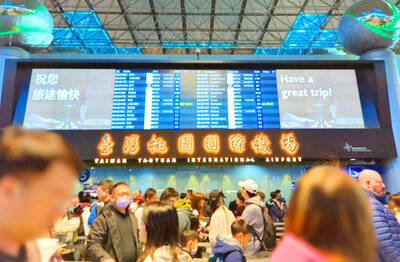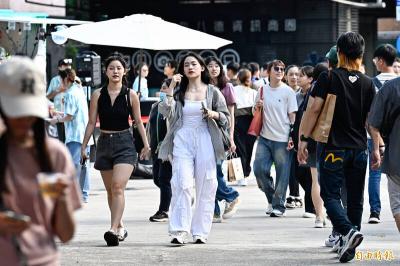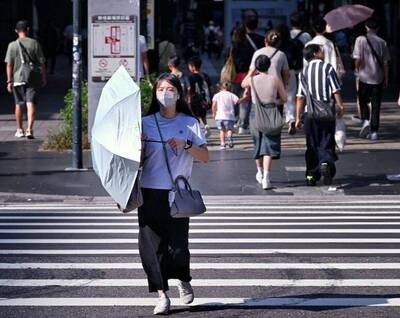Illegal miners have carted away up to NT$7 million (US$235,650) of gold from closed mines in New Taipei City’s (新北市) Jin Jiu area in the past five years, local residents say.
The Jin Jiu area, encompassing Jinguashih (金瓜石) and Jiufen (九份) in New Taipei City’s Ruifang District (瑞芳), was once a major gold-mining area until it was closed down by the Taiwan Metals Mining Company in 1987.
However, a geological survey conducted by a survey team from mining companies in Australia, South Africa, the US and Canada five years ago estimated that there was still about NT$200 billion — or about 200 tonnes — worth of gold left in the Jinguashih area, leading to a number of reports of illegal mining over the past five years.

Photo: Wu Liang-yi, Taipei Times
The Taiwan Metals Mining Company started mining the gold at Jinguashih after Japan surrendered in World War II, but rising costs of gold mining soon led the company to start up copper mining to compensate. Plummeting international prices for copper in the 1980s put the company in decline and it finally closed in 1987. The lands around the mining areas were turned over to the Taiwan Sugar Corp (Taisugar) for maintenance.
A geological survey conducted by National Taipei University of Technology associate engineering professor Yu Bing-sheng (余炳盛) showed that the area still held rich gold veins.
Out of the more than 4,000 samples he took, a tonne of rock usually held several hundred grams of gold, as well as other materials such as silver and copper, Yu’s survey found.
Eighty-year-old Chen Shih-cheng (陳石成), a retired miner living in the area, said earlier this week that strangers were often seen around the closed-down mine areas with semi-trucks and tools, adding that the strangers did not look like researchers or surveyors and were probably illegal miners.
A small path, obviously well-traversed, can be seen around the Niu Fu vein located at an altitude of 500m. While local residents said the vein’s four entrances had been sealed for 20 years by Taisugar, the seals have all been broken. There are also other signs — abandoned bottles and a small lean-to near one of the entrances — which the local residents said were evidence of illegal miners.
The locals say usually only about three months of the year were favorable for mining, and two strong men would be able to carry away 100kg of raw ore per day.
With between 50g and 100g of gold per tonne, and gold averaging about US$1,500 per ounce over the past five years, local residents estimate that illegal miners have carried away between NT$3 million and NT$7 million in the past five years.
Taisugar said entry into the old mines was prohibited, adding that there were many vertical shafts in the mines that would be impossible to climb out of if someone fell in.
The company periodically sends two people to patrol the mountains, but the total area of the land — about 2,000 hectares — is so large the company cannot monitor everything, Taisugar said.
The local police department said that they have also heard rumors that there were strangers dallying around the old mines and even leaving with mineral-bearing rocks, adding that they were unsure if it indicated long-term illegal mining.
The police said they had not received any reports of stolen goods.
The Bureau of Mines at the Ministry of Economic Affairs said that illegal mining was punishable by up to five years in prison and fines of between NT$200,000 and NT$1 million.
The bureau’s Ruifang District security personnel said that it was not easy to illegally mine gold these days, adding that the rumors of illegal mining were unsubstantiated.

Three Taiwanese airlines have prohibited passengers from packing Bluetooth earbuds and their charger cases in checked luggage. EVA Air and Uni Air said that Bluetooth earbuds and charger cases are categorized as portable electronic devices, which should be switched off if they are placed in checked luggage based on international aviation safety regulations. They must not be in standby or sleep mode. However, as charging would continue when earbuds are placed in the charger cases, which would contravene international aviation regulations, their cases must be carried as hand luggage, they said. Tigerair Taiwan said that earbud charger cases are equipped

Foreign travelers entering Taiwan on a short layover via Taiwan Taoyuan International Airport are receiving NT$600 gift vouchers from yesterday, the Tourism Administration said, adding that it hopes the incentive would boost tourism consumption at the airport. The program, which allows travelers holding non-Taiwan passports who enter the country during a layover of up to 24 hours to claim a voucher, aims to promote attractions at the airport, the agency said in a statement on Friday. To participate, travelers must sign up on the campaign Web site, the agency said. They can then present their passport and boarding pass for their connecting international

Temperatures in northern Taiwan are forecast to reach as high as 30°C today, as an ongoing northeasterly seasonal wind system weakens, the Central Weather Administration (CWA) said. CWA forecaster Tseng Chao-cheng (曾昭誠) said yesterday that with the seasonal wind system weakening, warmer easterly winds would boost the temperature today. Daytime temperatures in northern Taiwan and Yilan County are expected to range from 28°C to 30°C today, up about 3°C from yesterday, Tseng said. According to the CWA, temperature highs in central and southern Taiwan could stay stable. However, the weather is expected to turn cooler starting tonight as the northeasterly wind system strengthens again

Taiwan sweltered through its hottest October on record, the Central Weather Administration (CWA) said yesterday, the latest in a string of global temperature records. The main island endured its highest average temperature since 1950, CWA forecaster Liu Pei-teng said. Temperatures the world over have soared in recent years as human-induced climate change contributes to ever more erratic weather patterns. Taiwan’s average temperature was 27.381°C as of Thursday, Liu said. Liu said the average could slip 0.1°C by the end of yesterday, but it would still be higher than the previous record of 27.009°C in 2016. "The temperature only started lowering around Oct. 18 or 19